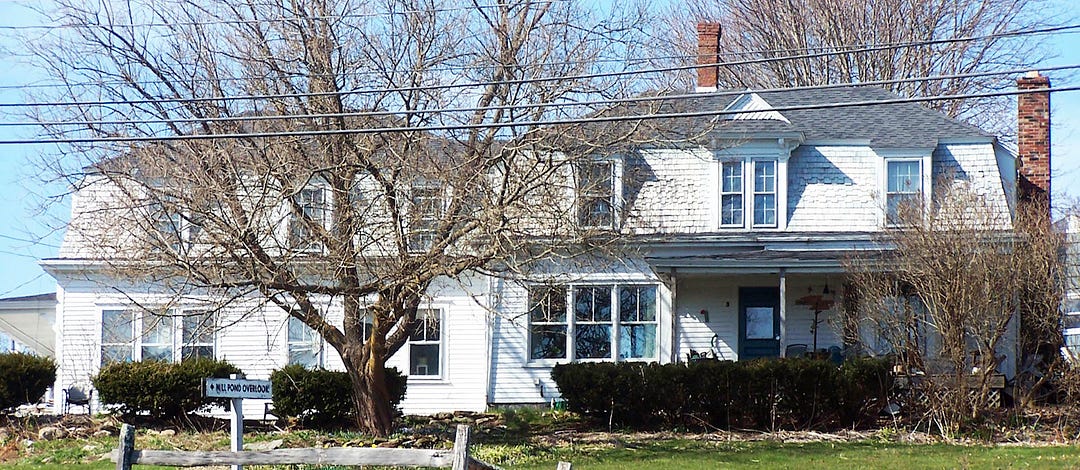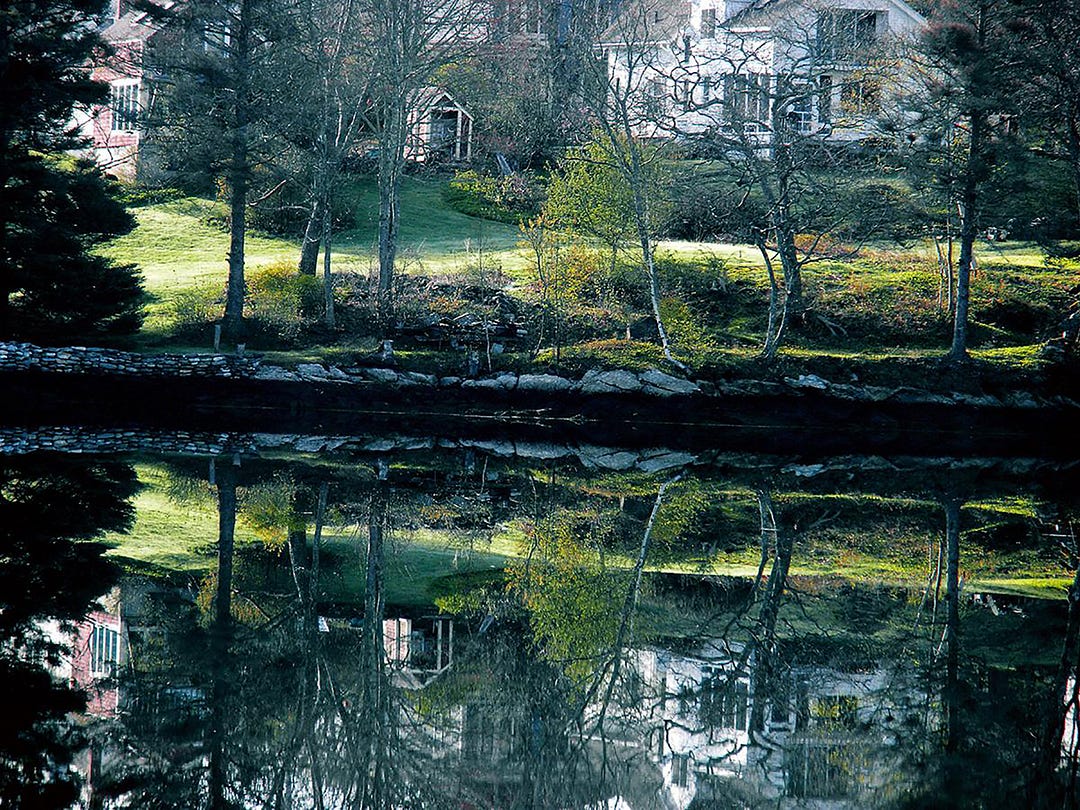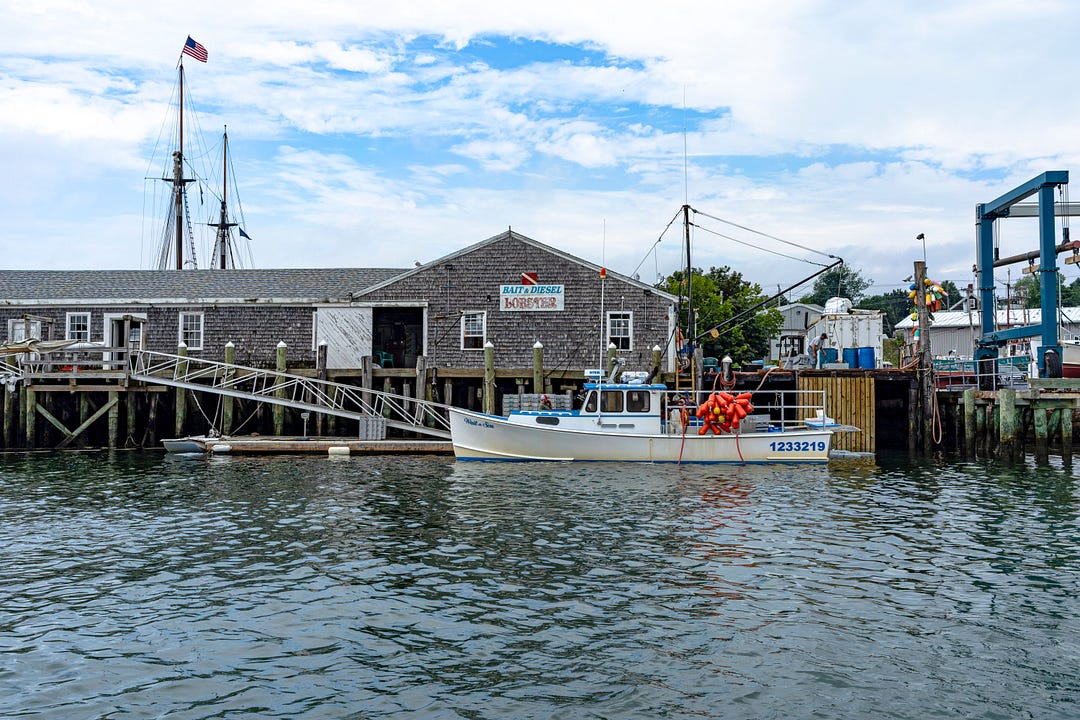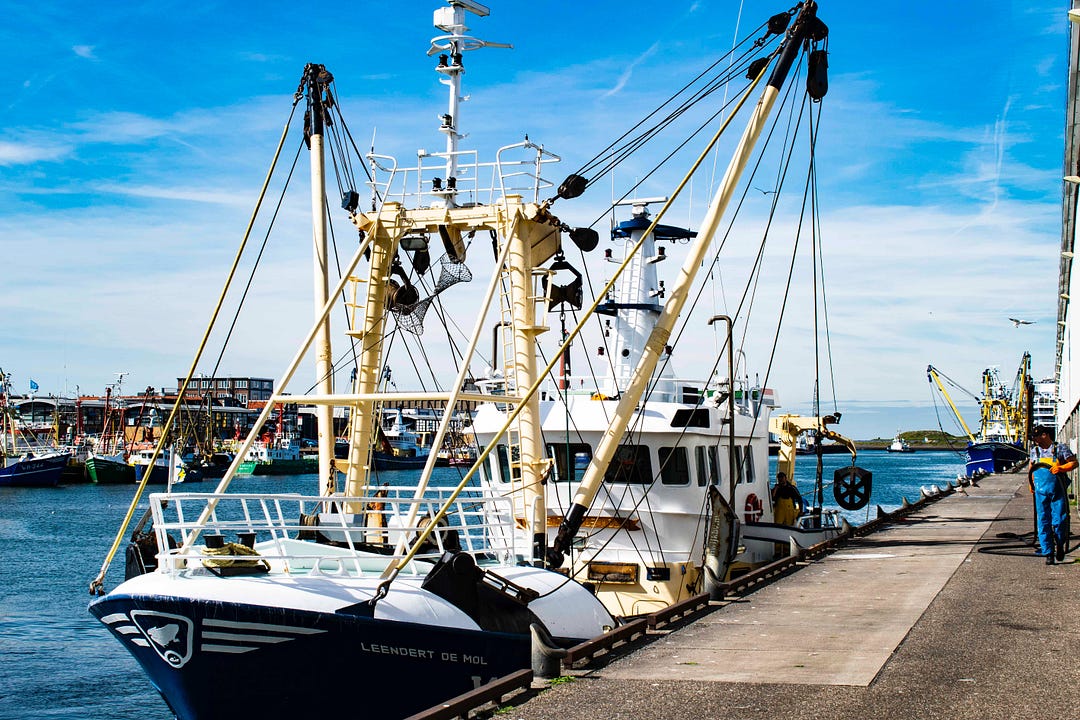Greed and the real estate boom in Boothbay Maine and an endangered water supply

brandon-griggs-unsplash
I was recently in an online dialogue in my local community where I encountered a developer willfully oblivious to the warnings from the state and the town water department concerning the danger posed by further development to Boothbay’s two water supplies.
The warnings came in five years ago when the development on the peninsula was already occurring at a faster than average pace and before the Botanical Gardens built a parking lot in the watershed and the Country Club developer finagled a dysfunctional rearrangement of roads in the center of town to his advantage.
The developer whom I shall call Howard, though it is not his name, expressed his vision for quadrupling the density of the village of East Boothbay, where Andersen Design’s production and home were located from 1958 to 2017.
Said by “Howard”: Low income housing should focus on rental units and cluster units like townhouses. Another approach would be to convert large summer homes to multi unit apartments. Easy to quadruple densities by doing that in East Boothbay. Of course all this will require substantial hikes in the property taxes.
Why substantial hikes in taxes? Why is Howard, the agent who is telling us so? Have we slid into the next phase of public-private relationships wherein special private interests openly dictate the rate of taxation?
Today every player in the power elite, be they public or private, for-profit or non-profit, talks as if they design the grand plan, for the public good of course. Remember what the Purpose Statement of the Financial Authority of Maine says. FAME inc set the tone for government by public-private relationships back in the 1980s:
Chapter 110: FINANCE AUTHORITY OF MAINE §962. Purpose: The authority will serve a public purpose and perform an essential governmental function in the exercise of the powers and duties conferred upon it by this chapter. Any benefits accruing to private individuals or associations, as a result of the activities of the authority, are deemed by the Legislature to be incidental to the public purposes to be achieved by the implementation of this chapter. [1985, c. 344, §5 (AMD).] [PL 1985, c. 344, §5 (AMD).]
Much to its credit, even local low-income-affordable housing provides more space and privacy than Howard envisions for East Boothbay. Is Howard thinking air b&b which provides the most profit per square inch and visitors do not need as much living space as residents need? Maybe it should be called East Air B&B in the future, instead of East Boothbay.
My former family business in a home was one of the first in East Boothbay to suffer at the hands of Howard-styled plans to realize the highest profit per inch by subdividing spacious homes into cubby hole living accommodations.
Our former home was once reconstructed during a more humanistic era when, contrary to being subdivided for profit into two one-room studio apartments and a “master suite” as it is now, two houses were put together into one home with two front doors and two porches.
The historic mansard style home was bulldozed over and replaced with the new-style architecture that does not waste money on a front door, let alone a front porch, and instead has three black garage doors lined up where there should be a welcoming entrance, shouting of the importance of automobiles over humans, and yet, whenever I drive by the automobiles are parked outside in front of the house.
Where once there were kitchen windows that took advantage of the splendor of southern light that streamed in at low angles during the winter, now there is a built-in overhang to an outdoor balcony reminiscent of balconies on city skyscrapers, that substitutes for a porch, allowing the space above the overhang to be used for valuable real estate footage. This design sets the windows back out of the sun’s direct reach. The only way to reclaim the glorious sunlight streaming into the living space is to eliminate any semblance of a porch on a building situated in the center of a New England town surrounded by homes with front doors and front porches.
One could take away the garages and transform the studio apartment into a more spacious and gracious living space but since the building is sub-divided with the entrance to the “master suite” being through a long hall that opens on the garage as if entering a city apartment building, or else entering by a difficult to access back door, one would have the problem of how to climb into the master suite. The only front-style door is recessed and hidden on the upstairs balcony, which does not have access from the ground. Maybe one could breakthrough into the long hallway to create a new entrance to the “master suite” (Even the language the realtor used to sell this construct has subversive implications)
Taxes did not increase when the old was destroyed and replaced with the new. Property taxes dropped by half of what we paid.

The home of Andersen Design from 1958–2017was historical when we moved in. My Dad added the triple windows to advantage of the exquisite sunlight provided by the location. Photo by Mackenzie Andersen
East Boothbay is a beautiful New England Village still preserved in the tradition of New England wisdom that Lewis Mumford writes about in the Culture of the Cities (and I discussed further in What Do Lessons from the Industrial Revolution Have to Tell Us Today? )
..the New England town during this period ceased to grow beyond the possibility of socializing and assimilating its members : when near crowding, a new congregation would move off under a special pastor, erect a new meeting house, form a new village, lay out fresh fields. Hiving off to new centers discouraged congestion in the old ones ; and the further act of dividing the land among the members of the community in terms of family need, as well as wealth and rank, gave a rough equality to the members, or at least guaranteed them a basic minimum of existence….A democratic polity-and the most healthy and comely of urban environments : a typical contrast to the despotic order of the dominant baroque city. To describe it is almost to define everything that the absolute order was not.Lewis Mumford The Culture of the Cities

That attitude prevailed for centuries. Until very recently the community was economically balanced including a wealthy sector that historically kept a low profile.
Once the Boothbay Peninsula was a place where families had summer homes, where generations gathered during the summer months. Howard would like to see these former homes broken up into subdivisions to serve the developer’s goal of a four-fold population expansion in East Boothbay. Just call it couch-potato town designed for lifestyles that do not require space or sun. Apparently, this is the citizenry type that Howard thinks is ideal for the Boothbay Region.

A few years ago a developer Paul Coulombe came to town with intentions to radically transform our peninsula into a luxury tourist destination. Since coronavirus hit, the vision held by developers has transformed into one part Hamptons, one part Silicone Valley, and one part Levittown.
NO PART- businesses in or attached to a home. Developers seem occluded to the fact of a new remote worker’s evolution afoot or that job development through businesses in or attached to the home does not require overcrowding the peninsula by building workforce housing to attract jobs from companies that require large workforces and mucho corporate welfare (could this be why Howard thinks taxes will have to be raised ?). The micro economy, including businesses in a home, whether workers for remote corporations, handcrafted makers, researchers. designers, mechanics, shipbuilders, cooks, tinkers, or tailors, create a community connected through work and grows at a pace that does not threaten our fragile water system, and does not aggressively increase the population but over time can shift the demographic balance, to include more young people, which is actually a need on the peninsula.
The micro economy does not, on the surface, promise to be a gold mine for venture capitalists and the like. On the surface, there are no ready-made billions on the horizon in such a community design, so who would be interested? Maybe the younger generation?
I have seen young people on Medium express great resentment toward the Baby Boomer generation, feeling that the older generation is keeping opportunities away from the younger generation and that they would just like to be able to live a middle-class lifestyle. Since Boothbay’s water supply does not support the population explosion targeted by the new developers, we could instead nurture the type of middle-class community that many of the younger generations yearn for, through small businesses, including home businesses which can be a new decentralized designated “opportunity zone” combining economic development with an affordable housing lifestyle, which is not “affordable” because it cramped, but because it incorporates individualized economic opportunity and space need to realize it.
Edgecomb, bordering on Boothbay permits businesses in the home and has an independent water supply. Perhaps the Boothbay wealth culture can provide a market for products and services made by the productive culture located in neighboring municipalities.
The New England village is already the desired garden city that post-Industrial Revolution urban planners sought to create. In the wake of the Industrial Revolution, a group of visionaries emerged including Ebenezer Howard, about whom Lewis Mumford says, “Ebenezer Howard may be said to be the first modern thinker about cities who had a sound sociological conception of the dynamics of rational urban growth,…because of its success in incorporating industries and in building workers’ houses, the garden city became a focal point in the mind of social-minded planners and administrators throughout the world.”.The founders of the Arts and Crafts Movement during the same era, John Ruskin and William Morris. led a handmade craft migration from urban to rural when most of humanity was moving in the other direction. Andersen Design was a new generation in that tradition in 1952 when my parents moved to the Boothbay Peninsula, where they could set up a business in a home to “create a hand-made product affordable to the middle classes”.
The Pre-Raphaelites believed the medieval world was purer in form than the post-Renaissance world because it was more closely tied to nature Roots of Arts and Crafts- University of Toledo
Boothbay is already a garden city but Boothbay’s new developers do not appreciate what Boothbay is. They want to make hay while the sun shines on Maine’s booming real estate market by building for a projected rapidly expanding population to justify changing ordinances, cramping living quarters, and squeezing houses together on small plots to make a profit while the market is hot, and they are pushing ahead aggressively.
Recently, Mr. Coulombe came out in support of a new forty-nine million dollar school for our peninsula, with no clear plan to finance it. According to Mr. Coulombe, the forty-nine million dollar school will solve the shortage of young persons on the peninsula. He is promoting a non-profit fundraiser with a goal of two-and-a-half million dollars to pay for the architects to design the school before the community has agreed that it is a reasonable idea.
And who wouldn’t support a school?
And thus a massive plan for population crowding is packaged as a school, and not as a plan to aggressively accelerate growth on the peninsula. The reason we need a school is to attract families to the area and so we also need a development project to build many new homes.

Voila- Enter a new non-profit organization called The Boothbay Region Housing Trust with the purpose ”to find some traction in securing projects leading to significant development in affordable workforce housing.” The reason we need affordable workforce housing is to attract businesses to the region, which will then attract the people to occupy housing developments.
Housing affordable to the working classes is few and far between on a peninsula reinventing itself as a high-end vacation destination, accelerated by the one type of business in a home that is permitted to proliferate without limit- the Air B&B.
Neither developers nor the new “affordable workforce housing” non-profit mentions the Air B&B’s, although if you need to increase taxes that is a good place to start since Air B&B’s are a direct cause of the shortage in housing affordable to a year-round population.
An article in the Boothbay Register is the only information currently available about The Boothbay Region Housing Trust. The article is written as if it is reporting minutes for a meeting without placing the subject under discussion in a larger context. At one point in the article, the leader of the non-profit, a realtor and developer activist, Debrah Yale is quoted as saying: “The towns recognize the need for affordable housing, but Boothbay Harbor has its hands tied by outdated and super restrictive ordinances, they said; no one has addressed the “archaic code from 1986” Yale said was a knee-jerk reaction to the Signal Point development and other condominium developments shortly before the change”
The Register article offers no explanation about the “archaic code from 1986” and so I asked, “What is the archaic code from 1986?”.
Receiving no answer, I researched it myself and found a report from 1986 that states the issue quite clearly in its findings: It is not archaic. It is current since we still have a working waterfront and a group working to preserve it.

Benjamin Rascoe-unsplash
The 1986 Ordinances
WATERFRONT DEVELOPMENT AND REVITALIZATION PROJECT
EXECUTIVE SUMMARY (1986)
Findings
1. Boothbay Harbor is the center of a $12-million-a-year Lincoln County
fishing, industry. This industry generates $36 million dollars of additional
revenues for the area and state. A commercial fish pier on the east side of
the harbor is economically viable if the volume of landings can be maintained;
2. Condominiums and other land uses are severely reducing the number and
quality of landing facilities available for commercial fish landing and proces-
sing. Current land use regulations are not adequate to resist development
pressures over the long term;
The realtor and developer activist, of the non-profit organization, Deborah Yale, makes such a to-do about the “archaic” ordinances of 1986 that she inadvertently revealed that the “workforce housing” being targeted by the new non-profit Boothbay Region Housing Trust are luxury waterfront condominiums, apparently already constructed but which cannot be inhabited because they violate the working waterfront ordinances.

Yale continues as if were an unassuming truth, requiring no debate, that waterfront condominium located in prime real estate settings are needed for “affordable workforce housing”, implying that the working waterfront should be sacrificed for condominiums, seemingly oblivious to the fact that a working waterfront employs a workforce. This attitude typifies the way that the developers are removed from the very realities that they claim to be serving. They want workforce housing but actual working people are mere abstractions to them used to justify their real estate expansions.
Yale continues with, “The knee-jerk might have been OK as a moratorium, but they never lifted those restrictions. now, if we lifted those restrictions, we could get into some of these developments which are already approved, hooked up to water and sewer, and they just sit there. There could be 44 homes built in the next two years for families if we could shrink the lot size … Just think of the tax implications of having all these vacant and vagrant houses and land without things being built on them and what it costs the town. They’re always trying to balance the budget, but if we had taxes coming in, we wouldn’t have to worry about all of that.”

And just think of all that money you could make if you could sell those condominiums and build houses on tiny lots in this hot market. Have pity on a poor realtor.
Much to its credit, even local low-income-affordable housing provides more space and privacy than Boothbay Region Housing Trust envisions for “affordable workforce housing” for the common class of workers.
Helping the poor by investing in the rich.
It’s a historical tradition in Maine to pass legislation to help the disadvantaged and soon thereafter use it to benefit the wealthiest. The Washington Count Development Authority and The Midcoast Regional Redevelopment Authority are both former military bases returned to civilian use and chartered by the Maine Legislature as “municipalities serving as an instrument of the state”, but WCDA is in Maine’s poorest county and MRRA is in Maine’s wealthiest country.
MRRA is a state-favored corporate welfare city. designated as a Pine Tree Zone, an act first passed for low-income high unemployment areas and four years later expanded to “statewide” as it “moved silently through the Legislature”, to quote exact words once found on the State Republican website. MRRA is also a designated Opportunity Zone enacted by the federal government in 2007 and described by the IRS as “Opportunity Zones are an economic development tool that allows people to invest in distressed areas in the United States.” When I checked a number of years ago reported income at MRRA was already three times higher than average for Maine.
WCDA is in a distressed area and is awarded an annual budget of zero dollars a year by the Maine Legislature and is not a designated zone for anything.
The idea that prime waterfront real estate should be used for “affordable workforce housing”, begs the question, what workforce is Ms. Yale anticipating? Perhaps Telsa will decide to locate on the Boothbay Peninsula if only we would build up with every square inch of open land with “affordable workforce housing”. Then perhaps the Telsa middle executive layer would pay market value for “affordable workforce housing” as luxury condominiums in prime oceanfront real estate in a town that doubles for a luxury tourist resort.
I pointed out that the 1986 ordinance was not intended as a temporary moratorium on condominiums on the harbor waterfront, the language used in the report is “permanent” and I suggested that if the realtors have condominiums they can’t use because of the ordinances why don’t they move them to areas more appropriate to “affordable workforce housing”?

I can only imagine how tiny our working waterfront would be if it weren’t for those ordinances, especially with Coulombe showing up and buying up properties across the peninsula to turn them into luxury accommodations, using any financial means possible, including turning a historic lighthouse into a modernized bed and breakfast under the front of a non-profit.
These developers, with gold dust in their eyes, are out of touch with reality. Much of the new migration from urban to rural is likely accountable to the remote worker’s movement, which are businesses in a home and which engage a different kind of lifestyle and philosophy than that of a company man in the gray flannel suit or whatever is today’s contemporary corporate uniform.
By my definition of twenty-first-century economic development, these developers are backward-looking to the Industrial Revolution, to what Lewis Mumford called the ‘Insensate Industrial Town”, except that industry is only an abstract talking point for them, one that justifies more building. They never actually have anything to say about industry beyond its function in justifying the overcrowding of the peninsula. They are out of touch with the issues of concern to younger generations, whom they want to attract to the area.
The culture that the new inhabitants might bring to a community has no interest for the do-gooding developers. When I commented that the boom in real estate sales was a “mystery demographics”. Howard responded that we should raise property taxes. No interest in the human side of the story, but economic development is a human story, not just a money story.
Lewis Mumford’s Insensate Industrial Town
In this passage from the chapter The Insensate Industrial Town. Lewis Mumford describes the common process through which cities become ghettos throughout the centuries and during the Industrial Revolution:
The system of construction was used to squeeze the last drop of rent out of a site by overcrowding the land, putting a thousand people on a spot that had hitherto accommodated but a hundred. Result: intensified land speculation, site-crowding, increased traffic congestion frequently lack of daylight and decent working space within the new buildings. Likewise a constant tendency to pyramid land values and structures, recapitalizing the original values on the basis of prospective congestion, and using the advance in values as an excuse for perpetrating further congestion. Finally, an urban form, towering against the skies, in which the actual living demands of men and women were subordinated at every step to pecuniary considerations. The Culture of the Cities by Lewis Mumford in chapyer titled THE INSENSATE INDUSTRIAL TOWN.

It recently occurred to me that the reason the developers show a remarkable lack of concern for the Boothbay Peninsula’s endangered water supply is that they project a population expansion so large it will serve as a tax base to finance pumping water into the peninsula from a remote source. I can only imagine that is a very large expense and also very political but developers base outcomes on future projections that are certain to work out exactly as they say, so that endangering the water supply is a justifiable risk in their minds, assuming that the water supply occupies space in their minds. The rapid growth that threatens to destroy the water supply will also pay for a new water supply, problem solved, no need to discuss it. Drop it! You are spoiling the party!
However, there is no reason to suddenly expand the population on the peninsula, other than making developers and other people invested in real estate richer. It is reasonable to attribute the current real estate boon to Maine’s low incidence of coronavirus and to attribute our low incidence to the fact that we are not an overcrowded state. It’s like killing the goose that laid the golden egg.
Coronavirus aside, Boothbay has its own unique appeal as it is because it is open and gracious and relaxed and a historical place but Coulombe and friends want to change that. They want Boothbay to be a luxury resort and its population to expand exponentially. Do the developers really believe that building “affordable workforce housing” will eventually be used for that purpose? Are they expecting major corporations to chose Boothbay as their headquarters over the nearby Midcoast Regional Development Authority with its full menu of tax exemptions, refundable tax credits, and subsidies, or do they privately project that they are creating an Air B&B city with cubbyhole size accommodations to increase the value per square foot?
Both towns have spent a lot of money and time over 35 years trying to get businesses to move to a region that cannot support the necessary workforce, Yale said. Watson added that among the issues which have gone unaddressed are the general recommendations as illustrated in the regional economic master plan presented in February 2018, and the need to reduce density requirements from 10,000 square feet per residential use to 5,000 square feet. Boothbay Region Housing Trust enters fold
The “Regional Economic Development Master Plan of 2018”
Watson and Kale are referencing the Camoin Report produced at distance by a New York consulting group, for a small fee of 79000.00 in taxpayer funding, contracted by the JECD Group, a special interest group masquerading as a community economic development organization.
I thank Watson and Kale for bringing it to our attention that the Camoin Report failed to address the most elemental challenge facing this peninsula, the sustainability of our water supply.
The 2018 “Town Plan” fails to mention the 2015 report from the water district that cites the danger posed by development to Adams Pond and Knickerbocker Lake. In the list of challenges we face, the Camoin Report mentions “Environmental effects on the Harbor (Effects on working waterfront, future of aquaculture, rising waters”) and “Waterfront zoning restrictions”, which would be the 1986 ordinances restricting condominiums and other commercial developments from infringing on the space needed by the working waterfront. A search for “Adams Pond” and another for “Knickerbocker lake” comes up empty.
The JECD paid the consultants. Consultants work for whoever pays them. The JECD got what it paid for, and now we can ignore it, as it fails to address a most crucial challenge facing this community- our fragile water supply. A report that does not begin with the right starting point, which in the 21st century includes limitations imposed by our natural environment, is good for nothing.
“trying to get businesses to move to a region that cannot support the necessary workforce”
To anyone taking a reasonable account of the entire region, the peninsula cannot compete with the MRRA, a business development city chartered by the Maine Legislature and situated within commuting distance to the peninsula. If Boothbay developers imagine that the peninsula will attract corporations, they are deluding themselves, unless it is a corporation that chooses Boothbay because of our unique natural resources, such in January of 2013 when we almost had a state of the art floating windmill project through the Norwegian company Statoil, when the Maine Public Utility Commission approved a project to build a $120 million deepwater wind turbine demonstration project off the coast of Boothbay Harbor.
Although everyone involved including the team at the University of Maine, the Wind Industry Initiative, Reed and Reed, a manufacturing company, and various member of the Legislature was thrilled with the project and with working with Statoil, Governor LePage opposed it, claiming the company had shown no commitment to working with local resources.
Statoil pledged to award contracts that represent 10 percent of capital spending — amounting to $100 million — for qualified Maine suppliers and contractors. LePage continued to object claiming the deal would be expensive for the taxpayers by raising the cost of energy but others said the increase was slight at only a few cents.
LePage held the signing of the Omnibus Bill hostage to force the legislature to pass LD 1472[1] changing the status that PUC had already granted to Statoil. The act re-opened the bidding process. Statoil pulled out citing uncertainty in regulations and the University of Maine formed a new public-private relationship named Aqua Ventus which submitted a proposal and was granted PUC approval, but that did not go to Boothbay Harbor.
In May 2014 the University of Maine received a federal grant for offshore wind project, but the three million dollar award is far less than $47 million that was anticipated to be granted to Statoil.
Statoil is now called Equinor- which built the first floating windmills off the coast of Scotland in 2017)
No one knows why LePage killed a project that had a global corporation, exactly the sort Lepage wants for Maine, in the hand. My completely unsubstantiated speculation connects LePage to his childhood friend Paul Coulombe who wanted to dredge the harbor and make it into a deep water port for very large cruise boats. Mr. Coulombe acts like the peninsula is his to design. Perhaps Statoili was stepping on Coulombe’s toes just as Coulombe would step on the toes of the fishing industry if he could. I am not knowledgeable enough to speculate on the effect of floating windmills on the feasibility of bringing large ocean liners to port in Boothbay Harbor, or of either project on the fishing industry but Governor LePage never said the floating windmills would threaten the fishing industry and so it is safe to assume that was not his motivation for killing the Statoil project and the many well-paid year-round jobs it would have brought to the peninsula.
Lack of affordable housing did not deter Statoil. Changing the PUC approval after the fact drove them away, like a Banana Republic.
The real deterrent to affordable living on the Boothbay Peninsula
The problem with affordable housing for year-round jobs is caused by the luxury tourism industry and the Air B&B’s but the other reality that no one talks about is that Boothbay cannot support another development-sized corporation that would require the kind of mass building of “workforce housing’ that developers are calling for. The idea that such mass building is being sold as required to create jobs tells us that those selling this idea intend corporations that equal or surpass the scale of the Botanical Gardens and the Country Club, which were cited, five years ago, as exacerbating the pressure on the water supply caused by an unusually rapid development on the peninsula. More likely the jobs are just another abstract talking point that developers use to sell their schemes to overcrowd the peninsula if they can get away with it.
Reality calls for a different working paradigm
If the leaders and people of the peninsula accept the consensus of the water department then the population on this peninsula has reached the limit that the water supply can reasonably sustain, it will require a different development paradigm than the one being pushed by the current developers cult. We need a more modest humanistic approach to development, consistent with Maine’s history when New England intentionally was part of a counter-culture to the overcrowding that reduced cities to ghettos. The developers love to hold up their “experts” like appeals to authority, so why aren’t they, and we, listening to the experts who tell us that our water supply is endangered?
The peninsula was never meant to grow at the pace that is currently being accelerated by the current real estate boom. It is great that our new Senator Chloe Maxmin, wants to add an amendment prioritizing the environment to the Constitution, but with the aggressiveness that developers are trying to accelerate building and aiming to decrease lots and living space sizes, we need to act sooner than an amendment can come about, lest our town leaders are as easily swayed by pressure from the real estate industry as they were swayed into agreeing that it was needed for “public safety” to plant a tree in the middle of our most traveled road and to construct a mini-roundabout around it, conveniently situated where a road leading to country club aggressively encroaches upon the road that once was a round-about the Commons.
Call Me David, Cause I have a vision too!

The Insensate Baroque Industrial Vacationland Levittown by the Sea
The Goliaths of Boothbay are drowning the airwaves with their unsustainable backward-thinking development nonsense!
A novel idea: Let’s open up the conversation to include reason!
Originally published at http://andersenstudiokisckstarterdiaries.blogspot.com on April 10, 2021.